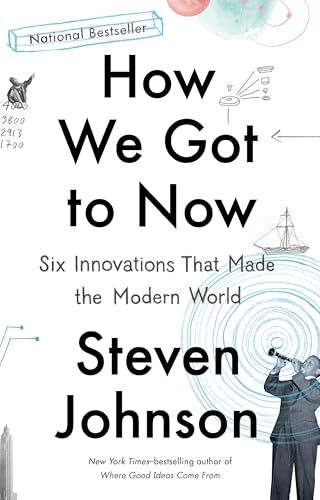
Another nice read from Steven Johnson on ideas and innovation. He does a great job of connecting many aspects of history and technology, focusing on 6 main inventions:
- Glass: windows, glasses, telescopes, touchscreens.
- Cold: icehouses, air conditioners, refrigerators.
- Sound: phonographs, sonar, radar.
- Hygiene: sewer systems, germ theory.
- Time: sundials, pocket watches, atomic clocks, CPUs.
- Light: candles, light bulbs, lasers.
There are a few wonderful insights throughout the book:
You never know what will be useful
The uses for any single technology and the connections between technologies are impossible to predict.
- The sonar technology used to find icebergs was later used to look at babies and, in some cases, abort them.
- The printing press led to more books, which led to more people realizing they needed glasses, which led to the mass production of lenses, which led to microscopes and telescopes, which completely changed how we see ourselves (cells!) and the universe (heliocentric!).
There are few lone geniuses and eureka moments
Technologies are rarely, if ever, invented by a single, lone genius, and almost never in a single flash of insight.
- New ideas usually develop over many years and occur to many people, independently, around the same time.
- That’s because new ideas live in the adjacent possible.
- No matter how brilliant you are, you can’t invent a telephone before people have discovered electricity, microphones, speakers, and dozens of other technologies.
- But once those technologies are available, the phone is in the adjacent possible, and it’s almost inevitable that someone (or many people) will figure it out.
The mirror changed how we saw ourselves (literally)
Before the invention of the modern mirror, around the mid 15th century, most people had never clearly seen their own faces.
- Sure, you could see it in water and various pieces of metal, but never with much clarity.
- Interestingly, individualism, self-awareness, and introspection become much more common around this time period (e.g., you start seeing self-portraits and novels written in the first-person).
- Does seeing yourself more often (or at all) lead to more of an obsession with yourself?
- Could it have helped fuel the renaissance?
Microphones and speakers changed who we could talk to
Before the microphone and speakers, it was impossible for a single human being to speak to an audience larger than ~1,000 people.
- No matter how great an orator or how great the acoustics, sound just can’t carry that far without amplification.
- The microphone made it possible to have rallies (including, unfortunately, Hitler’s rallies).
- Eventually, we could even record the sound of the voice and spread it far beyond what ever possible before.
Timekeeping made accurate scheduling possible
Before the invention of the first accurate timepieces, doing things on a precise schedule was largely impossible. Most people kept time based on work they did (“the time it takes to weave 10 yards”).
More accurate time keeping has enabled:
- Sailing (accurate timekeeping is required for navigation)
- Trains (which required synchronizing timekeeping between every town along the tracks)
- Computers (the clock in a CPU must be extremely precise)
- GPS (where 24 satellites circle the earth, reporting down their time, and your phone can triangulate your location by knowing where those satellites are and the slight differences in the time they are reporting)
Quotes
As always, I saved some of my favorite quotes from the book:
Most discoveries become imaginable at a very specific moment in history, after which point multiple people start to imagine them.
The lightbulb was the kind of innovation that comes together over decades, in pieces. There was no lightbulb moment in the story of the lightbulb.
